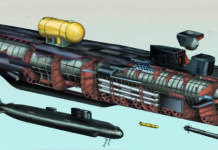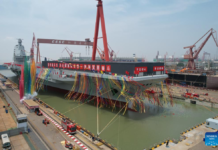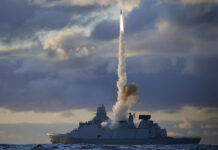In the morning of 7 July 2022, the Russian frigate ADMIRAL GORSHKOV (Hull number 454) passed through the Fehmarn Belt. She belongs to the Russian Federation’s Northern Fleet and is expected to take part in the Russian Navy’s fleet parade in Kronstadt/St. Petersburg. As part of a new Russian class of multi-role frigates, considered the successor to the KRIVAK class, the unit is 135 metres long and has a displacement of 5,400-tonnes. Two such units are currently in service, with six others in various stages of construction, of which ADMIRAL GOLOVKO is the most advanced.
Two additional frigates were ordered in August 2020 and according to experts, the Russian Navy needs thirty units to replace its remaining predecessors. Construction of the ADMIRAL GORSHKOV began in 2006 and her commissioning took place in 2018. Construction number 2, ADMIRAL KASATONOV was laid down in 2009 and entered service in 2020. According to an August 2021 announcement by the Severnaya shipyard, sea trials of construction number 3, ADMIRAL GOLOVKO, the construction of which began in 2012, may begin in mid-2022. Russian sources expect her to be handed over to the Navy before the end of 2022, and anticipate completion of the seven other frigates by 2027.
ADMIRAL GORSHKOV Statistics
The ADMIRAL GORSHKOV class (Russian: Project 22350) will deploy its main armament from a 16-cell Vertical Launch System (VLS). They can fire:
- KALIBR-NK land-attack cruise missiles (range 2 500 km)
- P-800 ONIKS anti-ship missiles (range 300-500 km)
- the hypersonic ZIRKON
- 91RTE2 anti-submarine missiles.
Another 32-cell VLS is reserved for medium-range anti-aircraft missiles and the armament is completed with:
- a 130-mm turret
- two 30-mm short-range anti-ship guns
- torpedo launchers
ADMIRAL GORSHKOV conducted a test firing of a ZIRKON-type hypersonic missile in the Barents Sea on 28 May. This is considered the first successful test of this weapon system at its full range. ZIRKON (Russian designation: 3M22 Tsirkon (Циркон), NATO designation: SS-N-33) is said to reach nine times the speed of sound (Mach 9). The payload is 300 kilograms. The warhead can be conventional or nuclear. The weapon system is designed for both sea and land targets and can be deployed by surface units as well as submarines. A land-based version is said to be under development.
ZIRCON Facts
As the world’s fastest non-ballistic missile and with its ability to manoeuvre in flight, ZIRKON poses challenges to Western missile defences. In this respect, against the background of the current situation, the presence of the ADMIRAL GORSHKOV in the Baltic means more than just sending a naval unit to celebrate the fleet’s anniversary. The situation, which deserves attention anyway due to the ISKANDER missile systems stationed in the Russian enclave of Kaliningrad, is getting a further aggravation.
Last year, Russian President Vladimir Putin had a trio of nuclear submarines launched in the Baltic Sea – a novelty at the time. Among them was the Russian Navy’s most modern nuclear weapon carrier, the submarine PRINCE VLADIMIRwith 16 possible intercontinental missiles and 96 nuclear warheads.
Navy Day is a bank holiday in the Russian Federation, traditionally celebrated on the last Sunday in July, honouring the sailors of the Russian Navy and its special forces. In 2022 it will be celebrated on 31 July. After Victory Day (9 May), Russian Navy Day (День Военно-Морского Флота) is considered the second largest military holiday in Russia. Since 2017, the central celebrations have been held in St Petersburg as a fleet parade of ships and flying units of the Baltic, Black Sea, Northern and Pacific fleets and the Caspian Flotilla. Events are also held at other naval bases. Navy Day was originally established in 1696, but was abolished by the Soviet Union in 1980. President Putin revived it.
Quoting Defence Minister Sergei Shoigu, TASS reported in early June that 47 floating units will participate this year.












